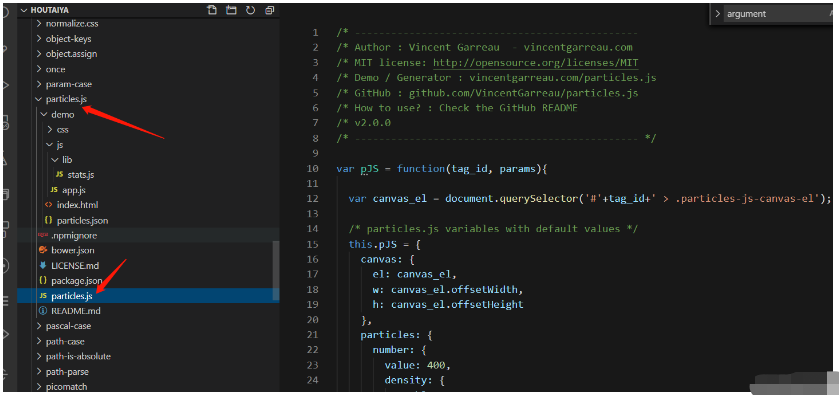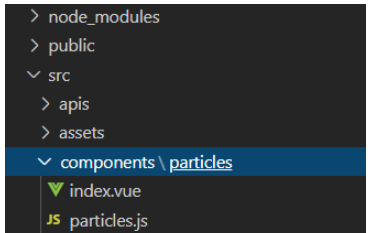这篇文章主要介绍了vue3使用particles粒子特效的问题怎么解决的相关知识,内容详细易懂,操作简单快捷,具有一定借鉴价值,相信大家阅读完这篇vue3使用particles粒子特效的问题怎么解决文章都会有所收获,下面我们一起来看看吧。
vue-particles 内部用了 require 这个api,vue3已经全面弃用了require,去拥抱 commonJSes6 了,改动了一个地方,其他地方也会出问题。
第一步:引入 particles.js
npm i particles.jsoryarn add particles.js第二步:找到 node_modules 内的 particles.js
把它弄出来 :

弄出来后可以用 npm uninstall particles.js 将依赖去除
第三步:项目 components 下创建 particles 目录
将找到的 particles.js 放进去后,在其同级目录创建 index.vue 与 particles.json:

第四步:index.vue 写入以下内容
<template> <div class="particles-js-box"> <div id="particles-js"></div> </div></template><script>import particlesJs from "./particles.js";import particlesConfig from "./particles.json";export default { data() { return {}; }, mounted() { this.init(); }, methods: { init() { particlesJS("particles-js", particlesConfig); document.body.style.overflow = "hidden"; }, },};</script><style scoped>.particles-js-box { position: fixed; width: 100%; height: 100%; top: 0; left: 0; z-index: 1;}#particles-js { background-color: #2d3a4b; width: 100%; height: 100%;}</style>第五步:particles.json 写入以下内容
{ "particles": { "number": { "value": 60, "density": { "enable": true, "value_area": 800 } }, "color": { "value": "#ffffff" }, "shape": { "type": "circle", "stroke": { "width": 0, "color": "#000000" }, "polygon": { "nb_sides": 5 }, "image": { "src": "img/github.svg", "width": 100, "height": 100 } }, "opacity": { "value": 0.5, "random": false, "anim": { "enable": false, "speed": 1, "opacity_min": 0.1, "sync": false } }, "size": { "value": 3, "random": true, "anim": { "enable": false, "speed": 40, "size_min": 0.1, "sync": false } }, "line_linked": { "enable": true, "distance": 150, "color": "#ffffff", "opacity": 0.4, "width": 1 }, "move": { "enable": true, "speed": 4, "direction": "none", "random": false, "straight": false, "out_mode": "out", "bounce": false, "attract": { "enable": false, "rotateX": 100, "rotateY": 1200 } } }, "interactivity": { "detect_on": "Window", "events": { "onhover": { "enable": true, "mode": "grab" }, "onclick": { "enable": true, "mode": "push" }, "resize": true }, "modes": { "grab": { "distance": 140, "line_linked": { "opacity": 1 } }, "bubble": { "distance": 400, "size": 40, "duration": 2, "opacity": 8, "speed": 3 }, "repulse": { "distance": 200, "duration": 0.4 }, "push": { "particles_nb": 4 }, "remove": { "particles_nb": 2 } } }, "retina_detect": true}第六步:修改 particles.js
1、1416行 - 1427行 替换为:
Object.deepExtend = function f(destination, source) { for (var property in source) { if (source[property] && source[property].constructor && source[property].constructor === Object) { destination[property] = destination[property] || {}; f(destination[property], source[property]) } else { destination[property] = source[property]; } } return destination;};2、最后一行添加:
export default window.particlesJS第七步:引入这里的index.vue
<template> <div> <particles></particles> </div></template><script>import Particles from '@/components/particles/index.vue'export default { components: { "particles":Particles }};</script>关于“vue3使用particles粒子特效的问题怎么解决”这篇文章的内容就介绍到这里,感谢各位的阅读!相信大家对“vue3使用particles粒子特效的问题怎么解决”知识都有一定的了解,大家如果还想学习更多知识,欢迎关注编程网行业资讯频道。





